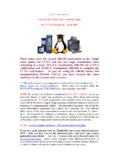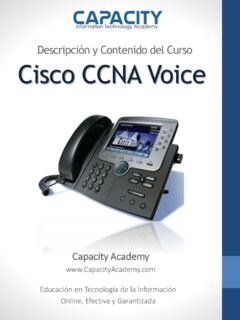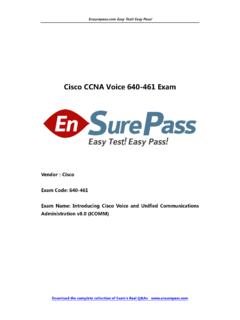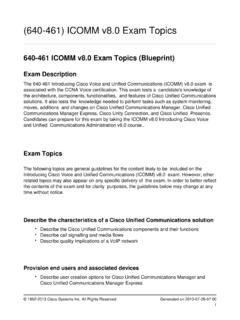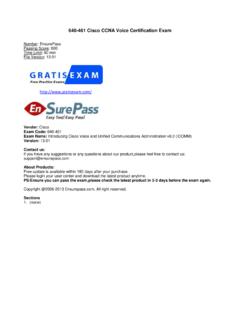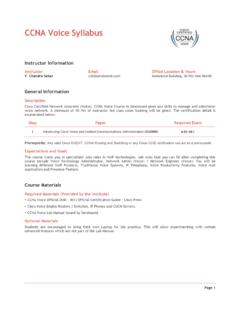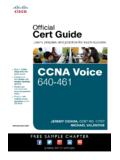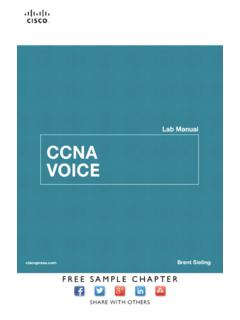Transcription of These notes cover the current 640-461 (ICOMM v8 ...
1 Cisco ccna notes -- Tech Note -- extracts from kccvoip ccna - voice training Cisco ccna - voice Check List - Training notes updated October 2012 These notes cover the current 640-461 (ICOMM v8) examination to complete the ccna voice certification. {extracted from kccvoip training} The following notes may help narrow the study topics to the relevant areas. The 'Study Summary' for each section highlights the main items covered by the examination. ** This information is not supported or endorsed by Cisco Systems, Inc. ** please report any errors/comments. NOTE the actual Vue/Pearson examinations DO NOT ALLOW you to go back and change or mark any questions, as many other demo and training examinations do.
2 AND not all questions are multiple choice and may require you to fill in the blank, drag & drop responses, telnet simulation or input your response to a diagrammatic exhibit (very few simulation questions as compared to the CCENT/ ccna exams). Unfortunately, there are many questions on the use of the web/GUI to configure the CUCM/CME and are now mainly non-technical questions regarding administration / We do try to fit in (when time permits) content from the original 640-460 course and items from CCNP- voice in order to keep the engineers interest and provide a better understanding of VoIP in the real-world.
3 See also ccna voice 640-641 example questions, IOS Configuration Examples, ccna voice 640-640 example questions The Vue / Pearson tests can be booked online via (since Cisco changed from Thomson/Prometric to Vue/Pearson there seems to be less testing centers available outside of the US, so check on their web site for centers and schedules in your area) PSTN and Legacy Telephony Study Summary REMEMBER Loop Start vs Ground Start and that LOOP START is susceptible to GLARE Supervisory Signaling On-hook signal Off-hook signal Ringing Address Signaling DTMF Pulse Informational Signaling (all the rest) Dial Tone Ringback Busy Congestion Reorder Receiver off-hook No such number Confirmation Analogue to Digital Conversion (human hearing range 20-20kHz at very best, human speech 200-9kHz, PSTN uses 300-3400Hz) Nyquist theorem (300Hz 4,000Hz, sample @ 2 x highest frequency) Sample (PAM) Quantize & Encode (PCM) Compress (CODEC) Time Division Multiplexing (TDM) time slots for each channel T1 has 24 x 64kbps channels mainly in the Americas and Japan E1 has 30 x 64kbps channels mainly in EU CAS = Channel Associated Signaling = uses the same bandwidth/channel as the voice or data.
4 T1 using CAS will steal bits (every eighth bit of every sixth DS0 time slot) often called robbed bit signaling (RBS). An ESF (extended super frame) T1 frame is sent as 24 DS0 frames (8 bits x 24) PLUS a single framing bit = 193 bits. The older SF (super frame) standard T1 frame was sent as 12 DS0 frames with framing bits on each of the DS0. E1 CAS does not use RBS but has DS0:1 for framing and DS0:17 for voice signaling not really CAS, but considered so because it uses the same format of ABCD bits as T1 and can therefore be compatible and interconnected. T1 and E1 will use loop start, ground start or E&M (1-5) for the interface connections and signaling (NOTE- Cisco do not support E&M type 4).
5 REMEMBER CAS T1 (rbs=8th bit every 6th frame), 24th timeslot (chan 23) for signaling, CAS E1 (framing on 1st timeslot =chan 0), 17th timeslot (chan 16) for signaling, configure for PSTN trunks using ds0-group # timeslots x-x CCS = Common Channel Signaling = complete channel for signaling uses a separate, dedicated channel (OUT OF BAND SIGNALING). T1 dedicates 24th time slot to signaling. E1 dedicates 17th time slot to signaling. Most popular signaling is and SS7. REMEMBER CCS T1 24th timeslot (chan 23) for signaling, configure for PRI trunks using pri-group # timeslots x-x and don t forget the global config to set the PRI ISDN switch type.
6 CCS E1 17th timeslot (chan 16) for signaling, configure for PRI trunks using pri-group # timeslots x-x and don t forget the global config to set the PRI ISDN switch type. REMEMBER THE PSTN TERMS Analogue telephone/fax/modem, local loop, central office (CO), trunk, private switch (PBX/PABX), digital telephone, ip telephone, numbering plans such as ITU (15 digit max) PBX FLAVORS Key Systems (PSTN to extensions - one to one) or PBX (internal dialing and PSTN sharing etc) or hybrid CODEC COMPLEXITY (for DSP sizing etc) (a-law and u-law), , and are medium , , iLBC, G729 and are high complexity REMEMBER RTP Real-Time Protocol and RTCP (Real-Time Control Protocol) and how they use their port numbers, payload types etc.
7 Cisco IOS Study Summary The examinations use a syllabus based upon extracts from IOS commands and basic knowledge of the current small enterprise network devices including the 29xx Catalyst series switches, 28xx G1, 29xx G2, 39xx G2 standard IOS ISR routers plus the CME, CUE and basics of the GUI for CME, CUE, CUCM, CUC and CUP. The latest 640-461 ccna voice now requires knowledge of IOS with Cisco Call Manager Express >7. It is possible to get-by using the trusty 26xx/28xx G1 routers and IOS > and CME >4, if you ensure you study the few missing commands that would be seen on the IOS 15xx and CME >7.
8 In addition to the equipment needed for the CCENT and ccna studies, and the capability of running Call Manager Express you will need two or more IP phones and soft phones (Cisco Communicator + CUPC) and access to the full Cisco Unified CallManager, Unity Connection and Unified Presence running on suitable servers or VmWare ESX server with sufficient capacity. This document is used as checklist within the KCC ccna voice FastTrack and Flex training courses; Switch and Router basic ops reminder and configuration as seen on the CCENT and ccna (memory use and RAM, FLASH, ROM, NVRAM) Router and Switch CLI (Command Line Interface) and exec mode basics for ; o interface and inline power configuration and monitoring o VLAN configuration for voice and data o CDP functions, DHCP, DNS, TFTP & ip phone boot sequence CME CLI for ; o setting up the CME as TFTP server o initial configuration requirements & file structure etc.
9 O ccna routing and addressing configuration reminder o dial-peer configuration o dial planning and digit manipulation configuration o CME GUI and it s limited functionality o service module configuration (CUE) [removed from exam 2011] o Cisco Unity Express features and specifications single number reach / unified mobility directory call forwarding call pickup intercom paging after-hours blocking CUCM ; o Dialplans and call flow o partitions and call search spaces o GUI access to serviceability, administration, OS and DRS o GUI service activation, features; extension mobility unified mobility native presence hunt groups intercom music on hold users, groups and rights o CLI o TFTP administration o basic knowledge of trunks and gateways CUC ; o GUI access to serviceability, administration, OS and DRS o GUI service activation, features o CLI o monitoring and reporting CUP ; o GUI access to serviceability, administration, OS and DRS o GUI service activation, features o CLI SUPPORT SERVERS/SERVICES ; o LDAP and AD o TFTP o DNS and DHCP o NTP o Provisioning & end-point boot process BASIC IOS FUNCTIONS REQUIRED BY CCNAV; (PRACTICE !)
10 FUNCTION COMMAND (may be abbreviated to first few non-ambiguous characters of each command) DHCP exclude ranges ip dhcp excluded-address {range} DHCP define pool ip dhcp pool {name} DHCP network network {network, mask} DHCP gateway default-router {address} DHCP DNS server dns-server {address} DHCP TFTP server option 150 ip {address} DHCP directed broadcast ip helper-address {server address} Practice configuration of voice VLAN and data VLAN connecting to a router on a different network for DHCP services. Remember your router on a stick from the ccna training and the ip helper commands CME GUI ADMIN FUNCTIONS REQUIRED BY CCNAV; REMEMBER to enable the GUI on CME you must configure.
